Abstract
This study was designed to determine whether transforming growth factor alpha (TGF alpha) protects rat gastric mucosa against ethanol- and aspirin-induced injury. Systemic administration of TGF alpha dose-dependently decreased 100% ethanol-induced gastric mucosal injury; a dose of 50 micrograms/kg delivered intraperitoneally 15 min before ethanol decreased macroscopic mucosal injury by > 90%. At the microscopic level, TGF alpha prevented deep gastric necrotic lesions and reduced disruption of surface epithelium. Pretreatment with orogastric TGF alpha (200 micrograms/kg) only partially (40%) decreased macroscopic ethanol damage. Intraperitoneal administration of TGF alpha at a dose of 10 micrograms/kg, which does not significantly inhibit gastric acid secretion, decreased aspirin-induced macroscopic damage by > 80%. TGF alpha protection does not seem to be mediated by prostaglandin, glutathione, or ornithine decarboxylase-related events, as evidenced by lack of influence of the inhibition of their production. Pretreatment with the sulfhydryl blocking agent N-ethylmaleimide partially abolished (40%) the protective effect of TGF alpha. In addition, systemic administration of TGF alpha resulted in a two-fold increase in tyrosine phosphorylation of phospholipase C-gamma 1 and in a time- and dose-dependent increase in levels of immunoreactive insoluble gastric mucin; these events occurred in a time frame consistent with their participation in the protective effect of TGF alpha.
Full text
PDF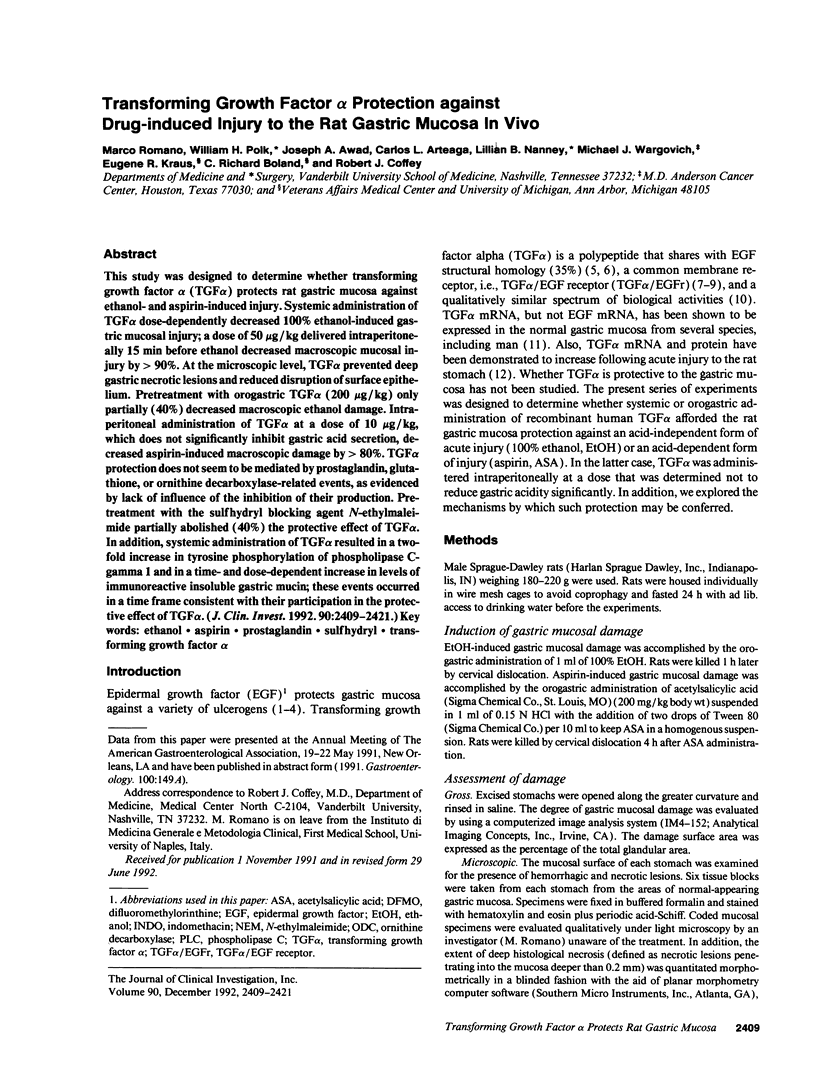

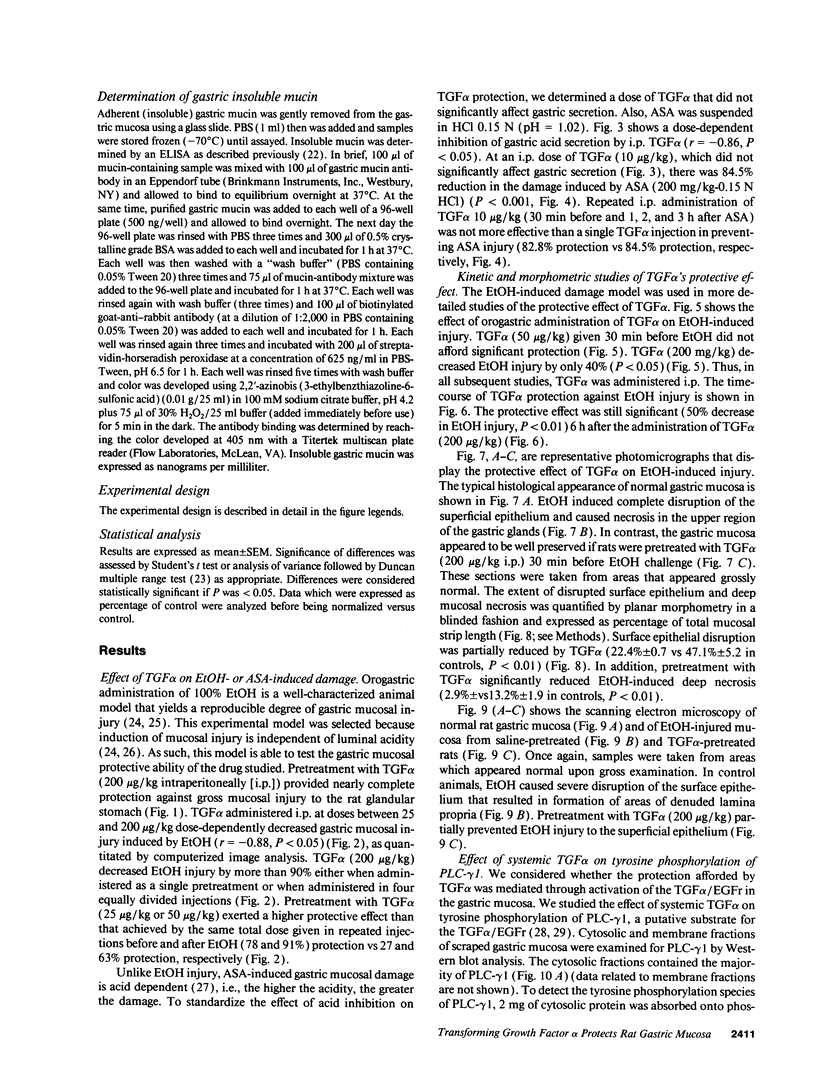




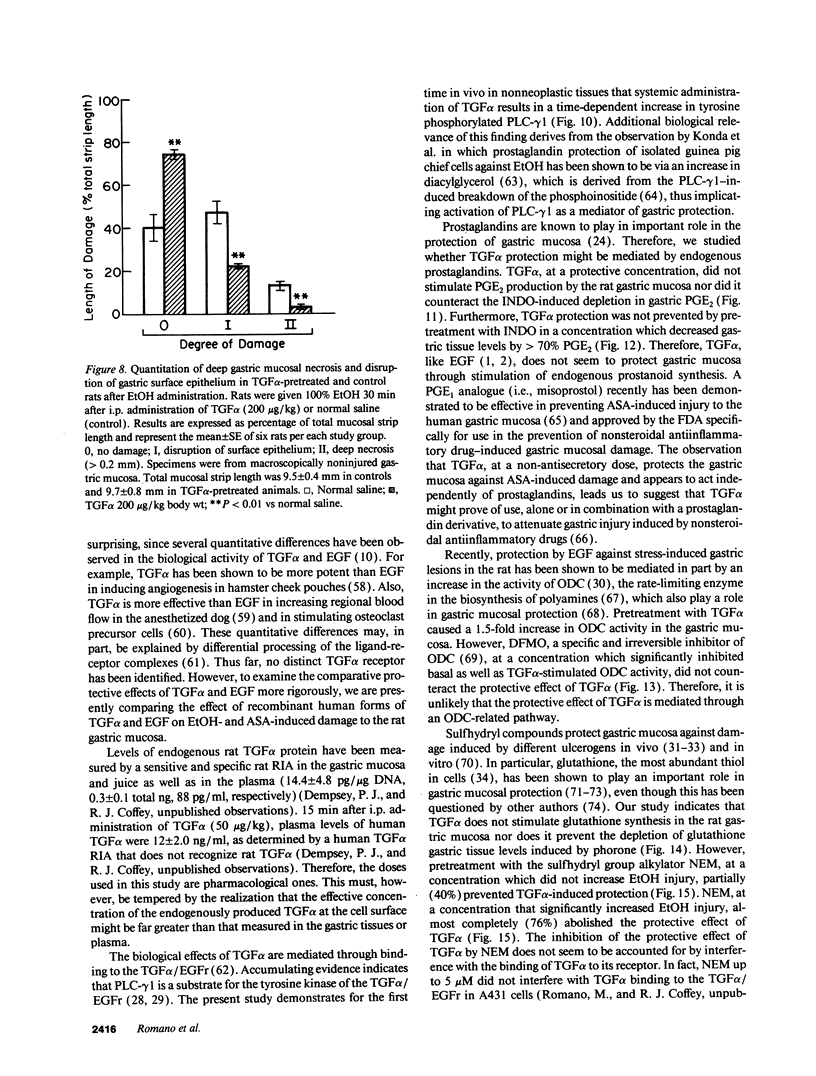

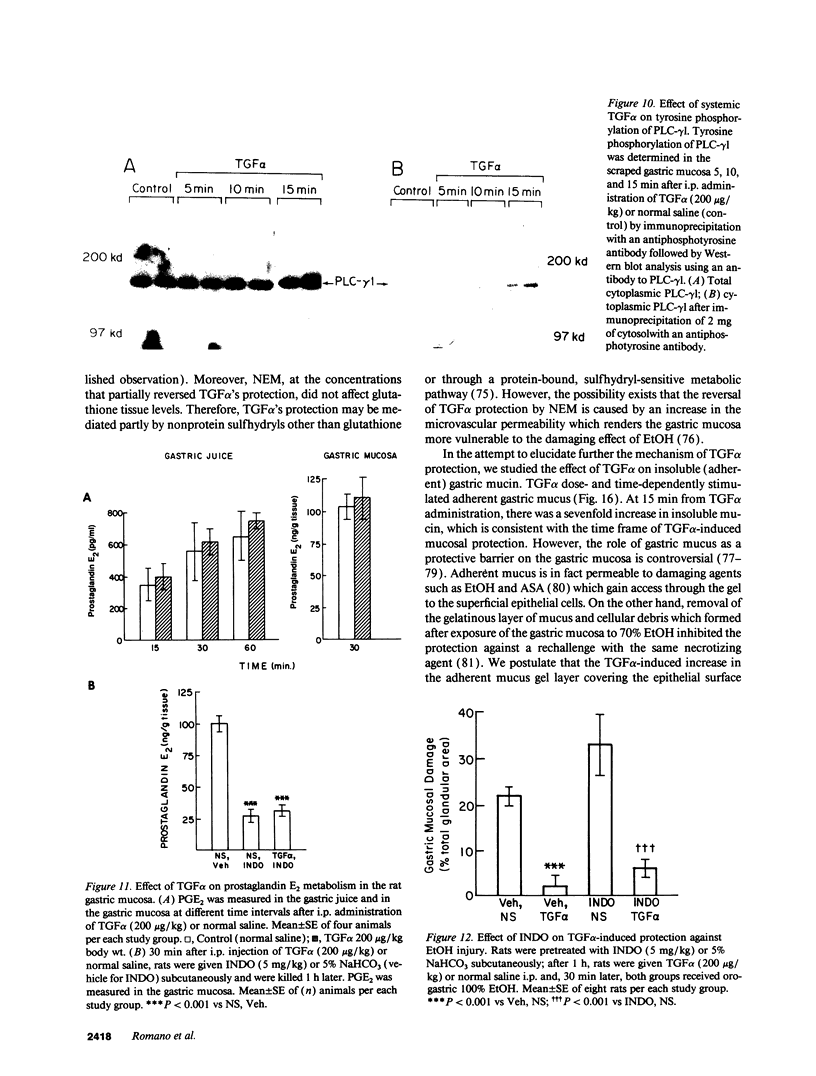
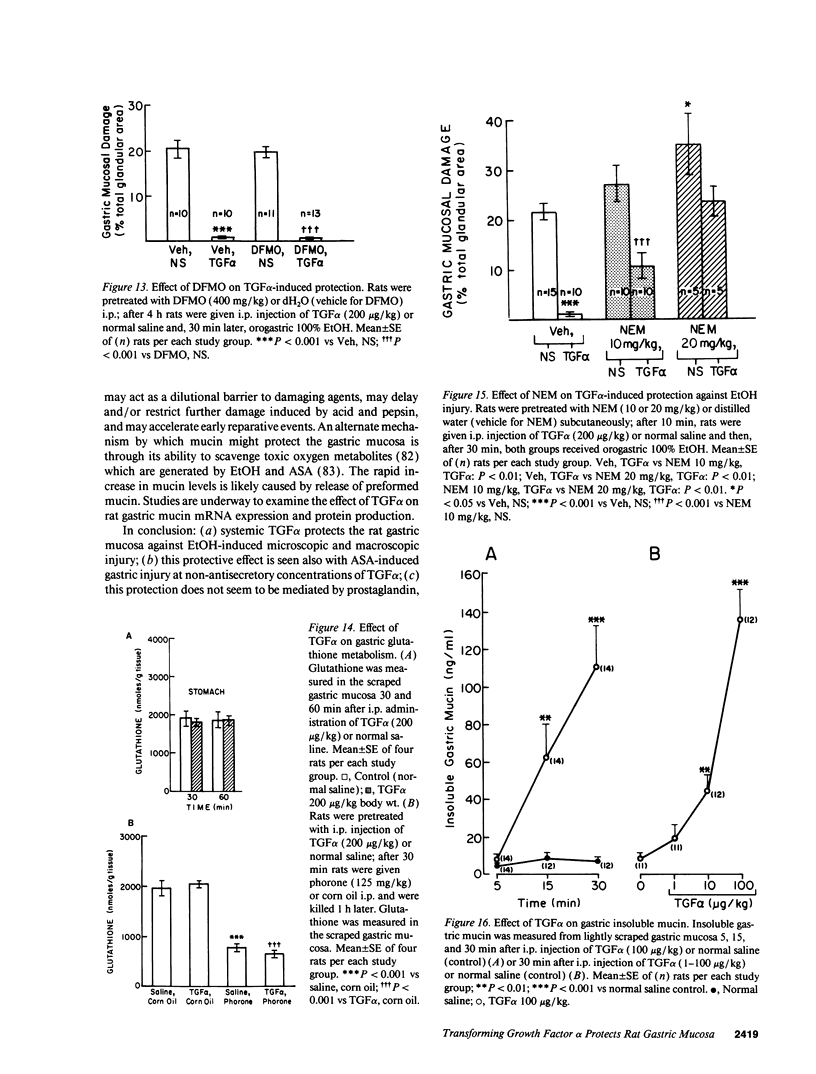
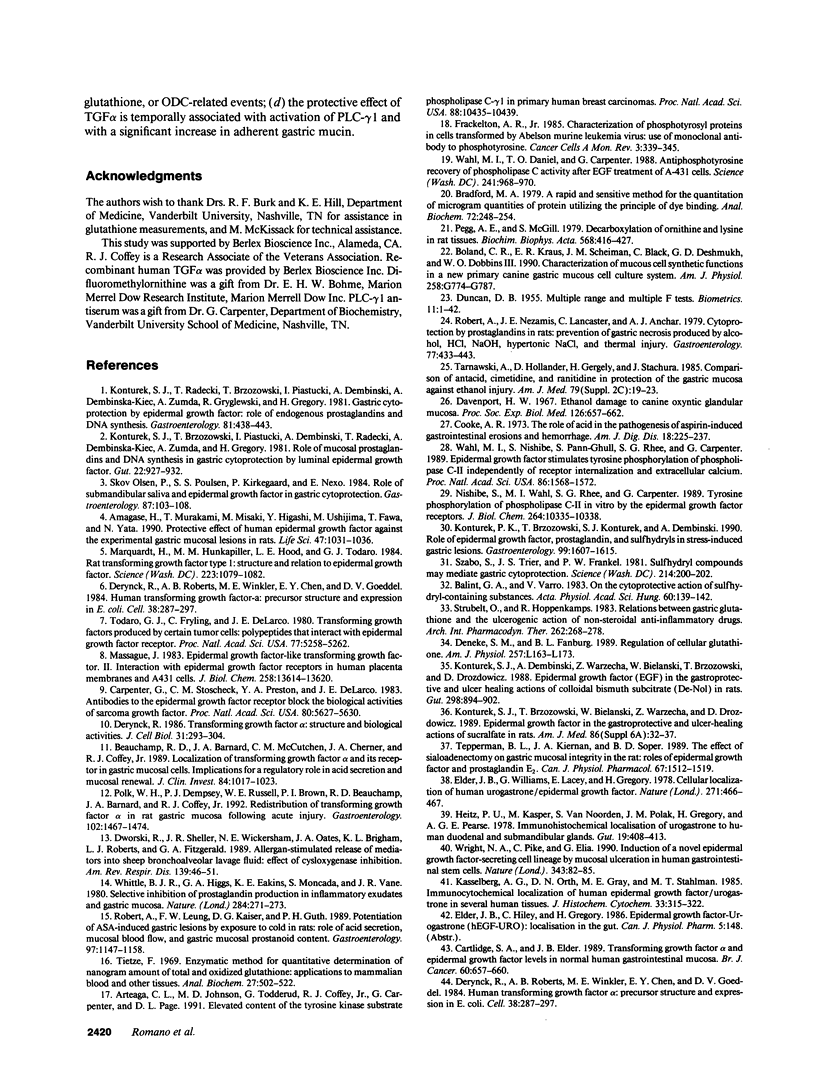

Images in this article
Selected References
These references are in PubMed. This may not be the complete list of references from this article.
- Amagase H., Murakami T., Misaki M., Higashi Y., Ushijima M., Fuwa T., Yata N. Protective effect of human epidermal growth factor against the experimental gastric mucosal lesions in rats. Life Sci. 1990;47(12):1031–1036. doi: 10.1016/0024-3205(90)90475-7. [DOI] [PubMed] [Google Scholar]
- Arteaga C. L., Johnson M. D., Todderud G., Coffey R. J., Carpenter G., Page D. L. Elevated content of the tyrosine kinase substrate phospholipase C-gamma 1 in primary human breast carcinomas. Proc Natl Acad Sci U S A. 1991 Dec 1;88(23):10435–10439. doi: 10.1073/pnas.88.23.10435. [DOI] [PMC free article] [PubMed] [Google Scholar]
- Beauchamp R. D., Barnard J. A., McCutchen C. M., Cherner J. A., Coffey R. J., Jr Localization of transforming growth factor alpha and its receptor in gastric mucosal cells. Implications for a regulatory role in acid secretion and mucosal renewal. J Clin Invest. 1989 Sep;84(3):1017–1023. doi: 10.1172/JCI114223. [DOI] [PMC free article] [PubMed] [Google Scholar]
- Berridge M. J. Inositol trisphosphate and diacylglycerol as second messengers. Biochem J. 1984 Jun 1;220(2):345–360. doi: 10.1042/bj2200345. [DOI] [PMC free article] [PubMed] [Google Scholar]
- Boland C. R., Kraus E. R., Scheiman J. M., Black C., Deshmukh G. D., Dobbins W. O., 3rd Characterization of mucous cell synthetic functions in a new primary canine gastric mucous cell culture system. Am J Physiol. 1990 May;258(5 Pt 1):G774–G787. doi: 10.1152/ajpgi.1990.258.5.G774. [DOI] [PubMed] [Google Scholar]
- Boyd S. C., Sasame H. A., Boyd M. R. Gastric glutathione depletion and acute ulcerogenesis by diethylmaleate given subcutaneously to rats. Life Sci. 1981 Jun 29;28(26):2987–2992. doi: 10.1016/0024-3205(81)90276-9. [DOI] [PubMed] [Google Scholar]
- Bradford M. M. A rapid and sensitive method for the quantitation of microgram quantities of protein utilizing the principle of protein-dye binding. Anal Biochem. 1976 May 7;72:248–254. doi: 10.1016/0003-2697(76)90527-3. [DOI] [PubMed] [Google Scholar]
- Bálint G. A., Varró V. On the cytoprotective action of sulfhydryl-containing substances. Acta Physiol Acad Sci Hung. 1982;60(3):139–142. [PubMed] [Google Scholar]
- Carpenter G., Stoscheck C. M., Preston Y. A., DeLarco J. E. Antibodies to the epidermal growth factor receptor block the biological activities of sarcoma growth factor. Proc Natl Acad Sci U S A. 1983 Sep;80(18):5627–5630. doi: 10.1073/pnas.80.18.5627. [DOI] [PMC free article] [PubMed] [Google Scholar]
- Cartlidge S. A., Elder J. B. Transforming growth factor alpha and epidermal growth factor levels in normal human gastrointestinal mucosa. Br J Cancer. 1989 Nov;60(5):657–660. doi: 10.1038/bjc.1989.334. [DOI] [PMC free article] [PubMed] [Google Scholar]
- Chen M. C., Lee A. T., Soll A. H. Mitogenic response of canine fundic epithelial cells in short-term culture to transforming growth factor alpha and insulinlike growth factor I. J Clin Invest. 1991 May;87(5):1716–1723. doi: 10.1172/JCI115189. [DOI] [PMC free article] [PubMed] [Google Scholar]
- Cooke A. R. The role of acid in the pathogenesis of aspirin-induced gastrointestinal erosions and hemorrhage. Am J Dig Dis. 1973 Mar;18(3):225–237. doi: 10.1007/BF01071977. [DOI] [PubMed] [Google Scholar]
- Danzin C., Jung M. J., Grove J., Bey P. Effect of alpha-difluoromethylornithine, an enzyme-activated irreversible inhibitor of ornithine decarboxylase, on polyamine levels in rat tissues. Life Sci. 1979 Feb 5;24(6):519–524. doi: 10.1016/0024-3205(79)90173-5. [DOI] [PubMed] [Google Scholar]
- Davenport H. W. Ethanol damage to canine oxyntic glandular mucosa. Proc Soc Exp Biol Med. 1967 Dec;126(3):657–662. doi: 10.3181/00379727-126-32532. [DOI] [PubMed] [Google Scholar]
- Davenport H. W. Salicylate damage to the gastric mucosal barrier. N Engl J Med. 1967 Jun 8;276(23):1307–1312. doi: 10.1056/NEJM196706082762308. [DOI] [PubMed] [Google Scholar]
- Dembiński A., Gregory H., Konturek S. J., Polański M. Trophic action of epidermal growth factor on the pancreas and gastroduodenal mucosa in rats. J Physiol. 1982 Apr;325:35–42. doi: 10.1113/jphysiol.1982.sp014133. [DOI] [PMC free article] [PubMed] [Google Scholar]
- Deneke S. M., Fanburg B. L. Regulation of cellular glutathione. Am J Physiol. 1989 Oct;257(4 Pt 1):L163–L173. doi: 10.1152/ajplung.1989.257.4.L163. [DOI] [PubMed] [Google Scholar]
- Derynck R., Roberts A. B., Winkler M. E., Chen E. Y., Goeddel D. V. Human transforming growth factor-alpha: precursor structure and expression in E. coli. Cell. 1984 Aug;38(1):287–297. doi: 10.1016/0092-8674(84)90550-6. [DOI] [PubMed] [Google Scholar]
- Derynck R., Roberts A. B., Winkler M. E., Chen E. Y., Goeddel D. V. Human transforming growth factor-alpha: precursor structure and expression in E. coli. Cell. 1984 Aug;38(1):287–297. doi: 10.1016/0092-8674(84)90550-6. [DOI] [PubMed] [Google Scholar]
- Derynck R. Transforming growth factor-alpha: structure and biological activities. J Cell Biochem. 1986;32(4):293–304. doi: 10.1002/jcb.240320406. [DOI] [PubMed] [Google Scholar]
- Dupuy D., Szabo S. Protection by metals against ethanol-induced gastric mucosal injury in the rat. Comparative biochemical and pharmacologic studies implicate protein sulfhydryls. Gastroenterology. 1986 Oct;91(4):966–974. doi: 10.1016/0016-5085(86)90701-8. [DOI] [PubMed] [Google Scholar]
- Dworski R., Sheller J. R., Wickersham N. E., Oates J. A., Brigham K. L., Roberts L. J., 2nd, Fitzgerald G. A. Allergen-stimulated release of mediators into sheep bronchoalveolar lavage fluid. Effect of cyclooxygenase inhibition. Am Rev Respir Dis. 1989 Jan;139(1):46–51. doi: 10.1164/ajrccm/139.1.46. [DOI] [PubMed] [Google Scholar]
- Ebner R., Derynck R. Epidermal growth factor and transforming growth factor-alpha: differential intracellular routing and processing of ligand-receptor complexes. Cell Regul. 1991 Aug;2(8):599–612. doi: 10.1091/mbc.2.8.599. [DOI] [PMC free article] [PubMed] [Google Scholar]
- Elder J. B., Williams G., Lacey E., Gregory H. Cellular localisation of human urogastrone/epidermal growth factor. Nature. 1978 Feb 2;271(5644):466–467. doi: 10.1038/271466a0. [DOI] [PubMed] [Google Scholar]
- Finke U., Rutten M., Murphy R. A., Silen W. Effects of epidermal growth factor on acid secretion from guinea pig gastric mucosa: in vitro analysis. Gastroenterology. 1985 May;88(5 Pt 1):1175–1182. doi: 10.1016/s0016-5085(85)80077-9. [DOI] [PubMed] [Google Scholar]
- Gan B. S., Hollenberg M. D., MacCannell K. L., Lederis K., Winkler M. E., Derynck R. Distinct vascular actions of epidermal growth factor-urogastrone and transforming growth factor-alpha. J Pharmacol Exp Ther. 1987 Jul;242(1):331–337. [PubMed] [Google Scholar]
- Gregory H., Thomas C. E., Young J. A., Willshire I. R., Garner A. The contribution of the C-terminal undecapeptide sequence of urogastrone-epidermal growth factor to its biological action. Regul Pept. 1988 Aug;22(3):217–226. doi: 10.1016/0167-0115(88)90034-1. [DOI] [PubMed] [Google Scholar]
- Griffin M. R., Ray W. A., Schaffner W. Nonsteroidal anti-inflammatory drug use and death from peptic ulcer in elderly persons. Ann Intern Med. 1988 Sep 1;109(5):359–363. doi: 10.7326/0003-4819-109-5-359. [DOI] [PubMed] [Google Scholar]
- Grisham M. B., Von Ritter C., Smith B. F., Lamont J. T., Granger D. N. Interaction between oxygen radicals and gastric mucin. Am J Physiol. 1987 Jul;253(1 Pt 1):G93–G96. doi: 10.1152/ajpgi.1987.253.1.G93. [DOI] [PubMed] [Google Scholar]
- Heitz P. U., Kasper M., van Noorden S., Polak J. M., Gregory H., Pearse A. G. Immunohistochemical localisation of urogastrone to human duodenal and submandibular glands. Gut. 1978 May;19(5):408–413. doi: 10.1136/gut.19.5.408. [DOI] [PMC free article] [PubMed] [Google Scholar]
- Ibbotson K. J., Harrod J., Gowen M., D'Souza S., Smith D. D., Winkler M. E., Derynck R., Mundy G. R. Human recombinant transforming growth factor alpha stimulates bone resorption and inhibits formation in vitro. Proc Natl Acad Sci U S A. 1986 Apr;83(7):2228–2232. doi: 10.1073/pnas.83.7.2228. [DOI] [PMC free article] [PubMed] [Google Scholar]
- Kasselberg A. G., Orth D. N., Gray M. E., Stahlman M. T. Immunocytochemical localization of human epidermal growth factor/urogastrone in several human tissues. J Histochem Cytochem. 1985 Apr;33(4):315–322. doi: 10.1177/33.4.3884705. [DOI] [PubMed] [Google Scholar]
- Konda Y., Nishisaki H., Nakano O., Matsuda K., Wada K., Nagao M., Matozaki T., Sakamoto C. Prostaglandin protects isolated guinea pig chief cells against ethanol injury via an increase in diacylglycerol. J Clin Invest. 1990 Dec;86(6):1897–1903. doi: 10.1172/JCI114922. [DOI] [PMC free article] [PubMed] [Google Scholar]
- Konturek P. K., Brzozowski T., Konturek S. J., Dembiński A. Role of epidermal growth factor, prostaglandin, and sulfhydryls in stress-induced gastric lesions. Gastroenterology. 1990 Dec;99(6):1607–1615. doi: 10.1016/0016-5085(90)90464-c. [DOI] [PubMed] [Google Scholar]
- Konturek S. J., Brozozowski T., Bielanski W., Warzecha Z., Drozdowicz D. Epidermal growth factor in the gastroprotective and ulcer-healing actions of sucralfate in rats. Am J Med. 1989 Jun 9;86(6A):32–37. doi: 10.1016/0002-9343(89)90154-x. [DOI] [PubMed] [Google Scholar]
- Konturek S. J., Brzozowski T., Piastucki I., Dembinski A., Radecki T., Dembinska-Kiec A., Zmuda A., Gregory H. Role of mucosal prostaglandins and DNA synthesis in gastric cytoprotection by luminal epidermal growth factor. Gut. 1981 Nov;22(11):927–932. doi: 10.1136/gut.22.11.927. [DOI] [PMC free article] [PubMed] [Google Scholar]
- Konturek S. J., Cieszkowski M., Jaworek J., Konturek J., Brzozowski T., Gregory H. Effects of epidermal growth factor on gastrointestinal secretions. Am J Physiol. 1984 May;246(5 Pt 1):G580–G586. doi: 10.1152/ajpgi.1984.246.5.G580. [DOI] [PubMed] [Google Scholar]
- Konturek S. J., Dembinski A., Warzecha Z., Bielanski W., Brzozowski T., Drozdowicz D. Epidermal growth factor (EGF) in the gastroprotective and ulcer healing actions of colloidal bismuth subcitrate (De-Nol) in rats. Gut. 1988 Jul;29(7):894–902. doi: 10.1136/gut.29.7.894. [DOI] [PMC free article] [PubMed] [Google Scholar]
- Konturek S. J., Radecki T., Brzozowski T., Piastucki I., Dembiński A., Dembińska-Kieć A., Zmuda A., Gryglewski R., Gregory H. Gastric cytoprotection by epidermal growth factor. Role of endogenous prostaglandins and DNA synthesis. Gastroenterology. 1981 Sep;81(3):438–443. [PubMed] [Google Scholar]
- Lewis J. J., Goldenring J. R., Modlin I. M., Coffey R. J. Inhibition of parietal cell H+ secretion by transforming growth factor alpha: a possible autocrine regulatory mechanism. Surgery. 1990 Aug;108(2):220–227. [PubMed] [Google Scholar]
- Malden L. T., Novak U., Burgess A. W. Expression of transforming growth factor alpha messenger RNA in the normal and neoplastic gastro-intestinal tract. Int J Cancer. 1989 Mar 15;43(3):380–384. doi: 10.1002/ijc.2910430305. [DOI] [PubMed] [Google Scholar]
- Marquardt H., Hunkapiller M. W., Hood L. E., Todaro G. J. Rat transforming growth factor type 1: structure and relation to epidermal growth factor. Science. 1984 Mar 9;223(4640):1079–1082. doi: 10.1126/science.6320373. [DOI] [PubMed] [Google Scholar]
- Massagué J. Epidermal growth factor-like transforming growth factor. II. Interaction with epidermal growth factor receptors in human placenta membranes and A431 cells. J Biol Chem. 1983 Nov 25;258(22):13614–13620. [PubMed] [Google Scholar]
- Mizui T., Doteuchi M. Effect of polyamines on acidified ethanol-induced gastric lesions in rats. Jpn J Pharmacol. 1983 Oct;33(5):939–945. doi: 10.1254/jjp.33.939. [DOI] [PubMed] [Google Scholar]
- Mori S., Morishita Y., Sakai K., Kurimoto S., Okamoto M., Kawamoto T., Kuroki T. Electron microscopic evidence for epidermal growth factor receptor (EGF-R)-like immunoreactivity associated with the basolateral surface of gastric parietal cells. Acta Pathol Jpn. 1987 Dec;37(12):1909–1917. doi: 10.1111/j.1440-1827.1987.tb03305.x. [DOI] [PubMed] [Google Scholar]
- Morris G. P. The myth of the mucus barrier. Gastroenterol Clin Biol. 1985;9(12 Pt 2):106–107. [PubMed] [Google Scholar]
- Mutoh H., Hiraishi H., Ota S., Yoshida H., Ivey K. J., Terano A., Sugimoto T. Protective role of intracellular glutathione against ethanol-induced damage in cultured rat gastric mucosal cells. Gastroenterology. 1990 Jun;98(6):1452–1459. doi: 10.1016/0016-5085(90)91075-h. [DOI] [PubMed] [Google Scholar]
- Nishibe S., Wahl M. I., Rhee S. G., Carpenter G. Tyrosine phosphorylation of phospholipase C-II in vitro by the epidermal growth factor receptor. J Biol Chem. 1989 Jun 25;264(18):10335–10338. [PubMed] [Google Scholar]
- Olsen P. S., Poulsen S. S., Kirkegaard P., Nexø E. Role of submandibular saliva and epidermal growth factor in gastric cytoprotection. Gastroenterology. 1984 Jul;87(1):103–108. [PubMed] [Google Scholar]
- Pegg A. E., McGill S. Decarboxylation of ornithine and lysine in rat tissues. Biochim Biophys Acta. 1979 Jun 6;568(2):416–427. doi: 10.1016/0005-2744(79)90310-3. [DOI] [PubMed] [Google Scholar]
- Pihan G., Regillo C., Szabo S. Free radicals and lipid peroxidation in ethanol- or aspirin-induced gastric mucosal injury. Dig Dis Sci. 1987 Dec;32(12):1395–1401. doi: 10.1007/BF01296666. [DOI] [PubMed] [Google Scholar]
- Polk W. H., Jr, Dempsey P. J., Russell W. E., Brown P. I., Beauchamp R. D., Barnard J. A., Coffey R. J., Jr Increased production of transforming growth factor alpha following acute gastric injury. Gastroenterology. 1992 May;102(5):1467–1474. doi: 10.1016/0016-5085(92)91703-7. [DOI] [PubMed] [Google Scholar]
- Rhodes J. A., Tam J. P., Finke U., Saunders M., Bernanke J., Silen W., Murphy R. A. Transforming growth factor alpha inhibits secretion of gastric acid. Proc Natl Acad Sci U S A. 1986 Jun;83(11):3844–3846. doi: 10.1073/pnas.83.11.3844. [DOI] [PMC free article] [PubMed] [Google Scholar]
- Robert A., Eberle D., Kaplowitz N. Role of glutathione in gastric mucosal cytoprotection. Am J Physiol. 1984 Sep;247(3 Pt 1):G296–G304. doi: 10.1152/ajpgi.1984.247.3.G296. [DOI] [PubMed] [Google Scholar]
- Robert A., Leung F. W., Kaiser D. G., Guth P. H. Potentiation of aspirin-induced gastric lesions by exposure to cold in rats. Role of acid secretion, mucosal blood flow, and gastric mucosal prostanoid content. Gastroenterology. 1989 Nov;97(5):1147–1158. doi: 10.1016/0016-5085(89)91684-3. [DOI] [PubMed] [Google Scholar]
- Robert A., Nezamis J. E., Lancaster C., Hanchar A. J. Cytoprotection by prostaglandins in rats. Prevention of gastric necrosis produced by alcohol, HCl, NaOH, hypertonic NaCl, and thermal injury. Gastroenterology. 1979 Sep;77(3):433–443. [PubMed] [Google Scholar]
- Romano M., Razandi M., Ivey K. J. Role of sulphydryl compounds in the defense of rat gastric epithelial cells against oxygen reactive metabolite-induced damage. Ital J Gastroenterol. 1991 Feb;23(2):55–59. [PubMed] [Google Scholar]
- Romano M., Razandi M., Raza A., Szabo S., Ivey J. Cysteamine protects gastric epithelial cell monolayers against drug induced damage: evidence for direct cellular protection by sulphydryl compounds. Gut. 1992 Jan;33(1):30–38. doi: 10.1136/gut.33.1.30. [DOI] [PMC free article] [PubMed] [Google Scholar]
- Scheving L. A., Shiurba R. A., Nguyen T. D., Gray G. M. Epidermal growth factor receptor of the intestinal enterocyte. Localization to laterobasal but not brush border membrane. J Biol Chem. 1989 Jan 25;264(3):1735–1741. [PubMed] [Google Scholar]
- Schreiber A. B., Winkler M. E., Derynck R. Transforming growth factor-alpha: a more potent angiogenic mediator than epidermal growth factor. Science. 1986 Jun 6;232(4755):1250–1253. doi: 10.1126/science.2422759. [DOI] [PubMed] [Google Scholar]
- Silverstein F. E., Kimmey M. B., Saunders D. R., Surawicz C. M., Willson R. A., Silverman B. A. Gastric protection by misoprostol against 1,300 mg of aspirin. An endoscopic dose-response study. Am J Med. 1987 Jul 27;83(1A):32–36. doi: 10.1016/0002-9343(87)90576-6. [DOI] [PubMed] [Google Scholar]
- Slomiany B. L., Liu J., Yao P., Wu-Wang C. Y., Keogh J. P., Wang S. L., Slomiany A. Characterization of the epidermal growth factor receptor in the gastric mucosa. Digestion. 1990;47(4):181–190. doi: 10.1159/000200496. [DOI] [PubMed] [Google Scholar]
- Strubelt O., Hoppenkamps R. Relations between gastric glutathione and the ulcerogenic action of non-steroidal anti-inflammatory drugs. Arch Int Pharmacodyn Ther. 1983 Apr;262(2):268–278. [PubMed] [Google Scholar]
- Szabo S., Trier J. S., Frankel P. W. Sulfhydryl compounds may mediate gastric cytoprotection. Science. 1981 Oct 9;214(4517):200–202. doi: 10.1126/science.7280691. [DOI] [PubMed] [Google Scholar]
- Tabor C. W., Tabor H. Polyamines. Annu Rev Biochem. 1984;53:749–790. doi: 10.1146/annurev.bi.53.070184.003533. [DOI] [PubMed] [Google Scholar]
- Takeuchi K., Okada M., Niida H., Okabe S. Role of sulfhydryls in mucosal injury caused by ethanol: relation to microvascular permeability, gastric motility and cytoprotection. J Pharmacol Exp Ther. 1989 Feb;248(2):836–841. [PubMed] [Google Scholar]
- Tarnawski A., Hollander D., Gergely H., Stachura J. Comparison of antacid, sucralfate, cimetidine, and ranitidine in protection of the gastric mucosa against ethanol injury. Am J Med. 1985 Aug 30;79(2C):19–23. doi: 10.1016/0002-9343(85)90567-4. [DOI] [PubMed] [Google Scholar]
- Tepperman B. L., Kiernan J. A., Soper B. D. The effect of sialoadenectomy on gastric mucosal integrity in the rat: roles of epidermal growth factor and prostaglandin E2. Can J Physiol Pharmacol. 1989 Dec;67(12):1512–1519. doi: 10.1139/y89-244. [DOI] [PubMed] [Google Scholar]
- Thompson J. F. Specific receptors for epidermal growth factor in rat intestinal microvillus membranes. Am J Physiol. 1988 Mar;254(3 Pt 1):G429–G435. doi: 10.1152/ajpgi.1988.254.3.G429. [DOI] [PubMed] [Google Scholar]
- Tietze F. Enzymic method for quantitative determination of nanogram amounts of total and oxidized glutathione: applications to mammalian blood and other tissues. Anal Biochem. 1969 Mar;27(3):502–522. doi: 10.1016/0003-2697(69)90064-5. [DOI] [PubMed] [Google Scholar]
- Todaro G. J., Fryling C., De Larco J. E. Transforming growth factors produced by certain human tumor cells: polypeptides that interact with epidermal growth factor receptors. Proc Natl Acad Sci U S A. 1980 Sep;77(9):5258–5262. doi: 10.1073/pnas.77.9.5258. [DOI] [PMC free article] [PubMed] [Google Scholar]
- Wahl M. I., Daniel T. O., Carpenter G. Antiphosphotyrosine recovery of phospholipase C activity after EGF treatment of A-431 cells. Science. 1988 Aug 19;241(4868):968–970. doi: 10.1126/science.2457254. [DOI] [PubMed] [Google Scholar]
- Wahl M. I., Nishibe S., Suh P. G., Rhee S. G., Carpenter G. Epidermal growth factor stimulates tyrosine phosphorylation of phospholipase C-II independently of receptor internalization and extracellular calcium. Proc Natl Acad Sci U S A. 1989 Mar;86(5):1568–1572. doi: 10.1073/pnas.86.5.1568. [DOI] [PMC free article] [PubMed] [Google Scholar]
- Whittle B. J., Higgs G. A., Eakins K. E., Moncada S., Vane J. R. Selective inhibition of prostaglandin production in inflammatory exudates and gastric mucosa. Nature. 1980 Mar 20;284(5753):271–273. doi: 10.1038/284271a0. [DOI] [PubMed] [Google Scholar]
- Wright N. A., Pike C., Elia G. Induction of a novel epidermal growth factor-secreting cell lineage by mucosal ulceration in human gastrointestinal stem cells. Nature. 1990 Jan 4;343(6253):82–85. doi: 10.1038/343082a0. [DOI] [PubMed] [Google Scholar]











